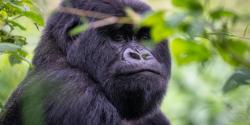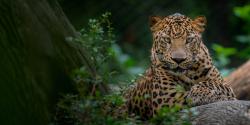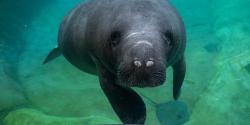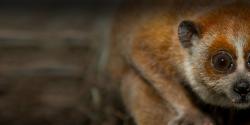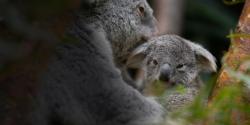Featured Species
Giant ground pangolin (Smutsia gigantea)
According to the U.S. Fish and Wildlife Services, pangolins may be among the most trafficked mammals in the world. Although the population of African pangolins is decreasing, there are still many cases of illegal exports of these animals to the Asian markets. The surge in African pangolin poaching for trade in Asian markets can be attributed to the overhunting of the native Asian species.
Conservation Status: Endangered, populations are decreasing
Habitat & Range: Throughout West and Central Africa in a broad range of habitats including primary and secondary rainforest formations, swamp forest, and savannah woodlands
Threats:
- · Hunting and poaching (bushmeat and use in traditional medicine)
- · Habitat loss and fragmentation
Saber-toothed cat (Nimravidae or the subfamily Machairodontinae)
The extinction pattern of the last of the saber-toothed cats closely followed that of the mastodons, which the species preyed upon. The Nimravidae family of animals from the Eocene through the Pleistocene Epoch, about 56 million to 11,700 years ago).
Conservation Status: Extinct
Habitat & Range: Saber-toothed cats roamed North America and Europe throughout the Miocene and Pliocene epochs (23 million to 2.6 million years ago). By Pliocene times, they had spread to Asia and Africa. During the Pleistocene, saber-toothed cats were also present in South America.
Extinct due to: loss of prey species due to climate change
Dire wolf (Aenocyon dirus)
The dire wolf differed from the modern gray wolf (Canis lupus) in several ways: it was larger with a more massive skull, a smaller brain, and relatively light limbs. The species existed during the Pleistocene period, about 2.6 million to 11,700 years ago.
Conservation Status: Extinct
Habitat & Range: The species was considerably widespread, and skeletal remains have been found in Florida, the Mississippi River valley, and the Valley of Mexico.
Extinct due to: loss of prey species due to climate change
Loggerhead turtle (Caretta caretta)
Currently the largest of all hard-shelled sea turtles, loggerhead turtles are a keystone species, integral to its ecosystem.
Conservation Status: Vulnerable, populations are decreasing
Habitat & Range: Found in coastal and open waters in nearly all the world's temperate and tropical oceans from the Atlantic Ocean from Newfoundland to Argentina, the Indian Ocean from southern Africa to the Arabian Gulf to western Australia, the Mediterranean Sea, and the Pacific Ocean from Alaska to Chile and Australia to Japan.
Threats:
- Bycatch, animals unintentionally becoming hooked or entangled in fishing gear, causing injury or death.
- Coastal development and rising seas from climate change are leading to the loss of critical nesting beaches
- Ocean pollution and marine debris ingestion and entanglement
Dodo (Raphus cucullatus)
This flightless bird is frequently cited as one of the most well-known examples of human-induced extinction. Like many animals that evolved in predators, the dodo was entirely fearless of humans. This fearlessness and its inability to fly made the dodo easy prey for sailors.
Conservation Status: Extinct by 1662
Habitat & Range: Mauritius (an island of the Indian Ocean)
Extinct due to:
- Over-hunting
- Introduced animals, including dogs, pigs, cats, rats, and crab-eating macaques, plundered nests and competed for the limited food resources
Kakapo (Strigops habroptila)
This large, flightless parrot is skilled at climbing trees and uses its wings like a parachute when jumping to the ground.
Conservation Status: Critically Endangered, populations are increasing
Habitat & Range: Originally widespread across New Zealand, they currently only found on small coastal islands surrounding New Zealand.
Threats: Invasive, human-introduced species such as cats, rats, introduced bacteria and diseases
Hill’s horseshoe bat (Rhinolophus hillorum)
These bats use echolocation to detect insects, which they then eat while in flight.
Conservation Status: Vulnerable, populations are decreasing
Habitat & Range: Endemic to the major highland areas of the Upper (Guinea and Liberia) and Lower (Nigeria and Cameroon) Guinean Forest of West Africa
Threats:
- Forest fragmentation and habitat degradation due to wildfires, farming, logging, and human development
- Severe weather caused by climate change
Thylacine (Thylacinus cynocephalus)
The thylacine’s body was most like a wolf’s; however, they were marsupials with pouches and were capable of hopping on two feet, similar to kangaroos.
Conservation Status: Extinct
It is estimated there were around 5,000 thylacines in Tasmania at the time of European settlement. On September 7, 1936, only two months after the species was granted protected status, the last known thylacine died.
Habitat and Range: The preferred habitat of Tasmanian wolves was never thoroughly described by scientists. Their original prehistoric range was thought to extend throughout much of mainland Australia and Papua New Guinea.
Extinct due to:
- Excessive hunting due to human wildlife conflict
- Introduction of invasive species like dingoes
- Foreign disease from introduced species
- Habitat destruction
King cobra (Ophiophagus hannah)
Though the king cobra is a large and dangerous snake, it prefers to escape, rather than attack.
Conservation Status: Vulnerable, populations are decreasing
Habitat & Range: Widely distributed in South and Southeast Asia in a variety of habitats, but primarily forests and agricultural areas
Threats:
- Habitat loss due to logging and agricultural expansion
- Harvested for skin, food, traditional medicine, and the pet trade
- Persecution by humans who are afraid of them
Praying mantis (Mantidae)
There are over 2,000 species of mantids, large, slow-moving insects with long front legs. Their coloration often offers them excellent camouflage.
Conservation Status: Unknown
Habitat & Range: Most are tropical or subtropical
Threats:
- habitat loss and degradation
- use of pesticides
- spread of invasive species


